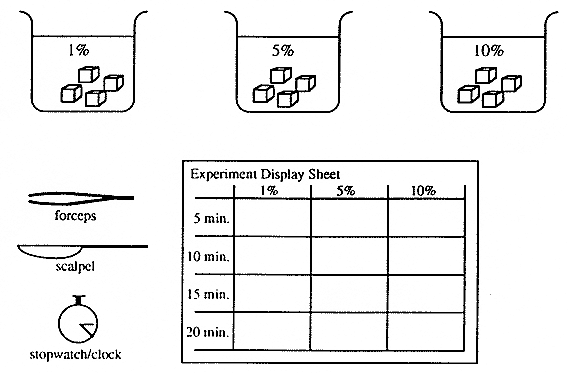 |
 |
|
|
|
|
Grades 9-12 Performance Task Part A - Experiment DesignIntroduction:This laboratory test presents a problem. Your task in Part A is to plan and design an experiment to solve the problem. You will have 30 minutes to complete Part A. At the end of the 30 minutes, your answer sheet will be collected. You will then receive separate directions for Part B. In Part B you will use materials and equipment provided in the laboratory kit to collect experimental data for this problem. You may wish to do your preliminary planning on the sheet labelled "Working Copy." Write this plan on the appropriate answer sheet in your test booklet.
a) State a HYPOTHESIS for this investigation that can be used to test the effects of time and concentration on diffusion. b) Under the heading PROCEDURE list in order the steps you will use to solve the problem. You may include a diagram to help illustrate your plans for the experiment. Include any safety procedures you would follow. c) Construct a DATA TABLE or indicate any other method that you could use to record the observations and results that will be obtained. PLEASE NOTE: In Part A you are NOT to proceed with any part of the actual experiment. You are just to plan and organize a way to investigate the problem. Materials:
WORKING COPYPART A - Experiment DesignThis sheet is provided as a work space (or scrap
sheet).
ANSWER SHEETPART A - Experiment DesignOrganize your experiment design under the following
headings: HYPOTHESISPROCEDURE (Include diagram if appropriate)DATA TABLE (For results and observations)Part B - Experiment ReportYou will have 50 minutes to complete this part. Record your work for Part B on the answer sheet under the appropriate headings. Perform the experiment by following the steps outlined in the procedure (listed below). Under the heading RESULTS record your observations and measurements for the experiment. Use written statements, descriptive paragraphs, tables of data, and/or graphs where appropriate. Construct a GRAPH which presents the relationship between the distance of diffusion into the potatoes and time and concentration. Under the heading CONCLUSIONS write an interpretation of your results. State the effect that time and concentration have on diffusion. At the end of 50 minutes, your answer sheet for Part B will be collected.
Procedure:
ANSWER SHEETPART B - Experiment ReportOrganize your experiment report under the following
headings: RESULTS
Construct your GRAPH on the graph paper provided.CONCLUSIONS |
